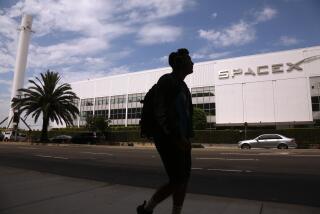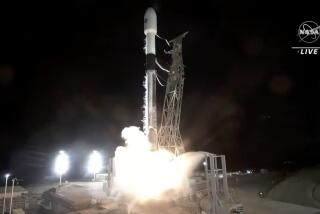Texan Faces Booby Trap in Paradise
- Share via
SOMBRERO ISLAND, Anguilla — It’s hard to imagine that Texas banker Andrew Beal--visionary, opportunist, entrepreneur--never factored in the booby bird when he found a better and cheaper way to reach outer space from this desolate slab of rock.
Beal, 46, parlayed real estate investments in the ‘70s into the largest privately owned bank in Dallas with assets of $1.4 billion. He taught himself advanced math without a college degree and, in 1997, offered a $50,000 prize to anyone who could solve “Beal’s Problem,” a theoretical teaser he designed so well it won high praise from top mathematicians and has yet to be solved.
And when Beal got to thinking one day back in 1995 why it cost the U.S. government $200 million to launch a satellite into orbit, he set about designing and building his own commercial rocket and launch pad. He has invested tens of millions of dollars in his 99%-owned Beal Aerospace Technologies, hired some of America’s top rocket scientists and discovered what he thought was the world’s perfect launch site here at what he called “the end of the world.”
Enter the brown booby, with its masked booby cousins and the brown noddies and terns. And the black lizard. A launch pad will kill them, environmentalists say. The species have lived for decades on these 98 acres of pitted, barren limestone with four lonely lighthouse keepers just beyond the point where the Atlantic meets the Caribbean.
Enter also Anguilla, the tiny British territory that happens to have dominion over Sombrero Island, 35 miles away.
Although many, including Anguilla’s semiautonomous elected government, favor Beal’s project as a quantum leap into the future, others see it as a step on the road to destruction.
Anguilla is one of the world’s most exclusive and pristine territories. Its 10,000 citizens inhabit a place where road signs advertise the Om Sweet Om Yoga Center and the flag features three interlocked leaping dolphins. Luxury tourist villas rent for up to $5,000 a night. Hundreds of Americans and Europeans have settled in million-dollar homes in recent years.
It is those wealthy settlers, and the lowly brown boobies, who are Beal’s biggest problems.
The Texan believes that he has found the perfect home for his three-stage satellite launch rocket and the facility to blast it into space. His projected $250-million personal investment would be the first economic activity here since fertilizer merchants stripped Sombrero of bird dung in the last century and abandoned the island as a worthless ruin.
“We purposely tried to find the middle of nowhere,” said Wade Gates, a crisis manager whom Beal hired as corporate relations director when the controversy boiled over here in February. “Out in the middle of nowhere is a good place to put a rocket launch pad.”
Demand for New Launch Pads is High
For rocket scientists, new commercial launch sites are critical to meeting the demands of the world’s telecommunications and high-technology boom. To expand, those industries need to put new satellites in orbit. But existing launch pads are overbooked, and aerospace analysts say new launch sites and rockets are needed to accommodate the dozens of commercial satellites now in production.
And for the scientists, Sombrero’s location lies in what they call the fan azimuth--a fan-shaped quadrant of airspace beginning at the launch site and ranging from due north to due east that is required to place satellites into geostationary and low orbits. Few nations have sites where that can be done without endangering cities or towns below the rocket’s flight path. But from Sombrero to the north and east, there is not a single piece of land or human settlement under that fan for thousands of miles--Nova Scotia to the north, Africa to the east and nothing in between.
“We firmly believe that if you took all the world’s environmentalists and put them in a room and asked them where in the world we should put our launch pad, they’d spend a year debating it and come back and tell us, ‘Sombrero Island,’ ” Beal said in a recent interview, adding that he was surprised by the outcry his plan has touched off from Anguilla to London.
“The idea that Sombrero is this pristine island that is perfect for birds just isn’t true. The launch facility is the best use of that island. In fact, it may be the only use.”
Local officials have been equally gung-ho. Although they concede that they thought Beal was crazy when he first approached them with the idea more than a year ago, the Anguillan government signed a tentative agreement with Beal last year to rent him Sombrero for 49 years at $280,000 a year, along with a promise from Beal of millions more in duties and customs revenues on everything he must import to develop his $20-million launch pad, buildings and runway on the rock--but all pending the outcome of ongoing environmental and security investigations both here and in Britain.
“I’m in favor of anything that brings positive results to Anguilla, and, by all appearances, the Beal Aerospace project appears to do that,” said Anguilla’s chief minister, Hubert Hughes, who blamed opposition to the project on U.S. and European settlers “who come to our tropical paradise and have their castles on the coast and then tell us how to live and die.”
For the pad’s opponents, whom Hughes calls “a very vocal minority” and Beal labels “CAVE people--Citizens Against Virtually Everything,” more than money is at stake.
Beyond the boobies, concerns here and in Britain now range from the safeguarding of Beal’s rocket technology from enemies of the West, to the impact of an explosion just a few dozen miles off the shores of an island where up-market tourism and fishing are the chief industries, to the very heritage and culture of Anguilla itself.
“It started with Christopher Columbus, and it continues through today. This is the discovery process all over again,” said Ijahnya Christian, executive director of the Anguilla National Trust, a quasi-governmental watchdog group that sponsors environmental protection and cultural awareness campaigns on the island.
“The Americans came to Sombrero more than a century ago, mined it out and left it as a ruin. Well, that’s now part of our heritage. But do we want another American to come here now and build a rocket launcher that fails and leaves behind yet another ruin that becomes part of our future heritage?”
The Trust, whose membership includes many of the wealthy Americans and Europeans who have built their dream homes in Anguilla during the past few decades, is taking a lead role in challenging Beal’s plan. Skilled in the Internet--a technology that depends on satellite launching ventures such as Beal’s--its members have created interlocking Web sites to mobilize opposition worldwide.
British Bird Society Takes Side of Booby
Using the booby and the Internet, a handful of Trust members sought and won the backing of Europe’s largest wildlife conservation group, Britain’s Royal Society for the Protection of Birds, which is now linked to the Trust’s Sombrero Web site.
That link to a powerful British lobby group with more than 1 million members has been instrumental in stalling Beal’s plan.
Although the British government has said the decision to build the launch pad rests with the Anguillan government, international law requires that London alone decide whether to issue the launch licenses that Beal needs because Britain is signatory to the treaties governing rocket and missile launches and is responsible for Anguilla’s foreign policy and defense.
“And unfortunately for Mr. Beal, this is all so new,” said Jim Stevenson, the Royal Society’s international program officer, who is coordinating the Sombrero campaign to protect the booby and the black lizard, a species that exists only on the island.
“The novel aspect to this is the proposal to launch a rocket from a British territory for the first time,” said Tom Perriment, assistant director of the British National Space Center, the agency responsible for issuing launch licenses. “We’re starting from scratch.”
At the moment, Perriment said, Beal’s proposal is under review by the British military, which must examine the viability, safety and international security not only of Beal’s commercial rocket and launch facilities but of a sensitive technology that could fall into terrorist hands.
Beal has submitted to Anguilla and Britain a 280-page environmental-impact study by a consultant approved by London. But for the project’s opposition, the study has raised almost as many questions as it answered.
For environmentalists such as the Royal Society’s Stevenson, the problem lies not in the booby’s status; it is not an endangered species.
“It is a fairly widespread bird,” he said. “I don’t want to overstate the case for Sombrero, but it is one of the last islands in the Caribbean with these seabird colonies. It’s not the death of the species. It’s just another nail in its coffin.”
Chief Minister Hughes insists that Sombrero’s boobies can simply join the thousands that cover some of Anguilla’s other uninhabited keys, saying: “If the booby is dislocated, it’ll just move to another island.”
“Wrong,” Stevenson said, explaining that, in short, the launch facility would wipe out Sombrero’s booby colony.
“The bigger birds are very faithful,” he said. “They won’t go to other islands. And the boobies in particular are very, very faithful.”
But the booby is not the chief concern of the fishermen who consider Sombrero’s waters the richest in the region, nor of the Anguillan chief lighthouse keeper who has lived here for 34 years.
“For me, it’s the rock itself. She can’t take the blast,” said Donald Lloyd, 57, who has manned Sombrero’s lighthouse since he helped build it in the 1960s to warn ships of the first piece of land they encounter as they approach the Americas through some of the world’s roughest seas.
Island Pocked With Craters, Caverns
Three decades of intensive phosphate mining, including thousands of surface and underwater detonations, have left the mile-long, quarter-mile-wide key a gutted wreck, pocked with 40-foot craters and gouged-out caverns and littered with millions of loose, jagged rocks.
One geologist whom Beal sent here for two days late last year noted in signing the official lighthouse log when he left: “Discovered a NW-SE fracture set traveling through the island, which may be tectonically related. Needs more study.”
Beal crisis manager Gates said the fractures were studied further by scientists, who concluded that they were not signs of an earthquake fault and that the rock can be made solid enough to withstand the blasts from the dozen rocket launches that Beal hopes to stage here each year. And all buildings, Gates added, will be sealed--”virtually terrestrial submarines”--to protect against hurricanes and the sea.
Through the island’s angst over a project that has packed community meeting halls, jammed Internet discussion groups, spawned UFO sightings and fueled conspiracy theories here since it became public last year, a fundamental question has been left unanswered for Sombrero: If not Beal’s launch pad, then what?
Lighthouse keeper Lloyd, who will soon be replaced along with his men--regardless of the outcome of Beal’s project--by a long-planned automated beacon, said rocket scientists aren’t the only ones who see value in Sombrero.
“If you don’t do something with it, we know who will take over this rock. The drug traffickers,” he said, pointing to what U.S. and British drug enforcement officials confirm is Sombrero’s strategic location along the Caribbean’s Colombia-to-America cocaine route. “We already see them offshore from time to time--airplanes dropping the drugs and the boats rushing to pick them up.
“We’ve got to do something with it, but I sure don’t know what.”
More to Read
Sign up for Essential California
The most important California stories and recommendations in your inbox every morning.
You may occasionally receive promotional content from the Los Angeles Times.










